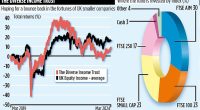
Achieving some of life’s biggest milestones has never been more expensive than it is for young people today.
Getting on the housing ladder costs around £60,000, those starting university now will be saddled with more than £42,000 of debt, and the cost of a wedding now typically breaches £20,000.
Understandably parents and grandparents often want to help out their loved ones to bring these milestones within closer reach.
However, few have six-figure sums lying about that they can afford to hand over at these crucial junctures.
An easier approach is to save a more manageable sum, regularly, to build up a sizeable sum by the time the money is needed.

Long-term plans: Parents would have to put aside £25.50 a month for 30 years to foot wedding bill
Wealth has calculated how much you would need to save every month to help them achieve these rights of passage.
Of course, the costs associated with these goals may have shifted by the time they come around, but the calculations may serve as a good starting point.
Paying university fees to avoid years of debt
Students who started university in September will graduate with £42,900 of debt, according to the Office for National Statistics.
Fees are typically £9,250 a year and students tend to have to borrow for living costs on top of that.
The outlay of the initial balance plus the interest is so high that the Government forecasts just 61 per cent of students will ever end up paying off their debt.
Students are typically advised to not worry about the debt, to treat it as a tax on earnings and accept that the remaining balance will eventually be wiped out – usually in 30 or 40 years’ time – should they not manage to clear the balance.
But some parents and grandparents can step in to pay some of these costs so that the students do not start their working life with a sizeable debt pile.
If saving for three years of university fees, you would need to put away £80.50 a month from birth to build up savings of £27,750 by the time they turn 18. This would pay for three years’ tuition based on the current fees of up to £9,250 a year. Fees may be revised up in the future.
As with all our figures, calculated by wealth advisers The Private Office, this assumes an annual return of 7 per cent, less 2 percentage points to account for inflation.
Putting cash aside for wedding over 30 years
According to official figures the average age of couples getting married is higher than ever before – with women 33 years old and men 35 – in part because it is so expensive. A wedding typically costs £20,700 according to wedding planning website Hitched. Parents or grandparents who want to plan ahead could save just £25.50 to have enough put aside after 30 years of saving.
Getting on the property ladder
This is one of the most expensive life events most of us face.
Naturally, relatives want to do all they can to help. But when the average deposit for a first-time buyer is £59,300, according to property website Zoopla, handing over a lump sum is not within everyone’s means.
However, by saving £135 a month from birth until your child turns 21, you could have accrued a nest egg big enough to pay for their deposit, figures from The Private Office show. Regional differences between house prices may be mean you would have to save more or less than the average deposit.
Zoopla’s average deposit is based on around 25 per cent of a house priced at £244,100. In the North West, however, the average first-time buyer home is £164,000 compared to £321,400 in the South East.
Saving this amount a month may be a struggle but don’t forget that others can pay into the account as well to help achieve your goal.
Best return for children’s savings
A Junior Isa is a tax efficient way of building up a nest egg. It has the advantage of being held in a child’s name, but cannot be accessed by them until they turn 18, unless in exceptional circumstances. Like an adult Isa you can choose between a cash or stocks and shares Isa – or open one of each. Interest paid, capital gains on investments or dividends earned are tax-free, boosting the growth of their pot of savings.
The maximum amount you can pay into your child’s Isa in the tax year 2024/25 remains unchanged at £9,000 per child.
Mark Chicken, independent financial planner at The Private Office, says: ‘Most parents want their children to have a strong financial footing when they are older. The type of account you choose depends on what access you want your child to have and the risk you are prepared to take with their money.
‘But starting as soon as possible can make a huge difference as can choosing the most tax efficient options. A Junior Isa is often the most obvious.’
Although it must be opened by a parent or guardian, once open anyone can deposit money directly into the account on birthdays or at Christmas, for example.
From the age of 16 your child can start to take a more hands-on approach with their savings by paying in or transferring money into a stocks and shares account.
At 18, they can withdraw the cash or keep it invested in an adult Isa or other account.
But until then, it is the parent or guardian’s decision over how they build up their child’s savings.
If you are concerned about taking a risk, the good news is that the top Junior cash Isas are paying up to 4.95 per cent, according to Savings Champion. Isa rates are up from around 2.5 per cent from December 2021.
‘It should be remembered that Junior Isa rates are variable so it’s important to review your rate on a regular basis,’ says Anna Bowes, of the comparison website.
Reme Holland, financial planning partner at accountancy firm Albert Goodman, says if you are considering investing in the stock market, you shouldn’t necessarily be put off by volatility.
‘If you’ve got a toddler and potentially many years of saving ahead, it’s a great opportunity to generate more returns using a stocks and shares Isa,’ he says.
‘With a cash Isa, you’ll be limiting your return in line with the level of interest rates.’
When investing in the stock market, experts say you should hold investments for at least five years to ride out any ups and downs share prices and fund values.
‘You can split your Isa allowance so that half is saved in cash and half is stocks and shares to mitigate some of the investment risks if that was a concern,’ Holland adds. ‘Lots of funds also adopt a more cautious approach to investing. If you’re not 100 per cent sure of your options, seek independent financial advice.’









